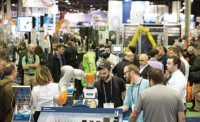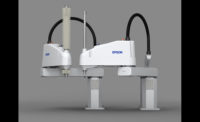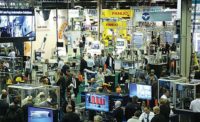More than 150 exhibitors will display the latest manufacturing products and services at the inaugural ASSEMBLY Show South April 4-6 at the Music City Center in Nashville, TN. Fasteners, power tools, adhesives, dispensing equipment, conveyors, robots, software and, of course, automated assembly systems are among the myriad new products on display.
To draw attention to the breadth and quality of new technologies on display, we’re holding a “Best in Show” contest at the event, and you—the attendees—will be the judges. We’ve nominated 10 products that we think are particularly innovative. All you have to do is vote for your favorite on the show floor.
Voting will be open throughout exhibit hall hours on Wednesday, April 5. The winners will be announced on Thursday, April 6, at 9:30 a.m.
Modular Platform for Automation
Flexbase is a configurable, modular platform for automation. It enables manufacturers to standardize production equipment, simplify engineering and maintenance, and adapt quickly to rapidly changing production requirements. It also provides a lower risk path to transition manual processes to semiautomatic or fully automatic production.
Available in 4- or 6-foot standard models, Flexbase can be configured as a standalone automated workstation or linked together to create a complete assembly line. Optional conveyors can be configured for over-under pallet recirculation.
The cell is ISO 6 compliant and can be FDA-validated with a documentation package. It has a maximum height of 7.5 feet to fit through a standard 8-foot doorway and includes built-in levelers. It is also ergonomically designed to accommodate a standing or sitting operator. The platform can be used for a variety of processes, including assembly, sorting, testing, handling, fastening and joining.
Fully integrated Allen-Bradley controls are adaptable to various automated operations. The IIoT-ready control system includes IO-link enabled hardware and OEE Optimizer machine analytics software. Booth 329
Automation Nth
Roller Forming With Servo-Controlled Articulation
The Electric EA30 is the first roller-forming machine with servo-controlled articulation. With three individually programmable servos, the Electric EA30 can execute a variety of profile shapes in a single stroke. The forming capabilities include traditional roller forming, articulating roller forming, 3D articulating roller forming, and crimping.
Servo-controlled radial motion delivers higher precision and control compared to conventional equipment, which requires manual adjustment of a mechanical stop. All three servo motors are aligned within the unit, giving the machine a slim design. As a result, the machine is well-suited for integration into automated production lines with limited space. It can also be used as part of a stand-alone work cell for prototyping or low-volume production where frequent changeover of nests and programs may be necessary.
HPPi software allows programming and quick adjustment of the forming process using the HMI. The software monitors all aspects of the forming process and stores the process data. The data can be exported through an industrial data interface (OPC/UA), enabling integration into higher-level production management systems.
The primary advantages of the technology are flexibility in forming; programmability and control of the vertical, radial and rotary motions; and real-time feedback of the forming process parameters. Additionally, this technology can reduce cycle time compared to conventional machines, which may require multiple forming steps to produce the same part. Booth 511
BalTec Corp.
Fast SCARA Robots for High Payloads
The GX4 and GX8 SCARA robots are equipped with Epson’s patented Gyroplus technology to provide fast speeds, smooth motion control, and high payload capabilities. The robots are available in multiple arm configurations, with maximum reach of 650 millimeters. They can handle a maximum payload of 8 kilograms. The robots have a slim design for easily integration into clean room and static-safe environments.
Epson’s RC+ software works seamlessly with the GX Series robots. With battery-less encoders, a built-in Ethernet cable, and other useful features, the GX Series have a low total cost of ownership.
Gyroplus technology provides real-time velocity feedback directly at the end of the robot arm. This feedback is incorporated into the servo control loop, allowing the robot to achieve high precision and reducing vibration and settling time.
Traditional robot controls use angular velocity feedback located on the robot’s motor. But the true angular velocity at the end of the robot arm often differs from the motor’s angular velocity due to mechanical tolerances, friction, and the influence of peripherals, such as end effectors and wiring. Previously, the most effective ways to reduce vibration were to increase rigidity by using a larger robot or to reduce acceleration and deceleration time. But these solutions mean increasing the robot’s footprint and cost or reducing cycle time and throughput.
Gyroplus technology addresses these problems by mounting an angular velocity sensor at the end of the robot arm. Now, the robot controller receives information about the behavior at the end of the arm and can deliver motion commands to address the exact movement and position of the robot arm, rather than an estimate based on the motor’s velocity. This means more precise positioning control and significant vibration reduction. Booth 535
Epson Robots
Robotic System for High-Speed Clip Placement
The Clip Placement System feeds plastic clips at high rates of speed in automotive assembly applications. The system feeds clips at a rate three times faster than conventional methods. It accommodates standard-size plastic clips used to assemble automotive interior panels and other parts.
The system comes standard with a stainless steel hopper for a bulk supply of clips. A vibratory feeder bowl singulates and orients the clips. A blow feed mechanism shuttles the clips to end-of-arm tooling on a robot for placement. The assembly cell has a compact footprint of 36 by 45 inches, including controls. It easily integrates with assembly stations and other equipment.
The system can be paired with a six-axis or SCARA robot. Complete systems are available through an integration partner. Booth 744
Hoosier Feeder Co.
Probe Checks Assemblies for Leaks
The Strix sensor and hand probe are ideal for leak testing a wide range of automotive systems and components, including engine assemblies, air-conditioning systems, battery cases, brake lines and fuel systems. The Strix is 30 percent lighter than the company’s P60 hand probe, and its tip is 12.5 percent smaller for easier access to hard-to-reach checkpoints.
Strix systems are faster and more accurate, as well. Complex algorithms shorten measurement times, improve accuracy and speed recovery times when compared to similar handheld systems. The probe’s sensor has an expected lifetime of one year or more, reducing overall ownership costs and downtime when compared to sensors that need replacement three to four times a year.
Connected to an INFICON Sentrac hydrogen leak detector, the probe uses a safe, nonflammable mixture of hydrogen and nitrogen as a tracer gas to find leaks. Hydrogen is readily available in most countries at a much lower cost than helium-based tracer gas.
With forming gas injected into the product, such as a refrigerant circuit or large EV battery pack, an operator can then use the probe to detect escaping gas. A probe does not draw gas into the unit for analysis. Instead, the sensor is located at the tip of the probe to further improve response time and reduce dust build-up in the instrument to lower maintenance costs.
The probe gives a clear signal and provides intuitive guidance, helping the operator to easily pinpoint and quantify leaks. The new sensor also recovers faster after detecting a leak, rapidly returning to its normal state even after high exposure to tracer gas. With the signal clearing quickly, the operator is able to save time and continue leak searches without delay.
Even extremely large leaks can be identified without oversaturating the detector. The device also handles high background levels of hydrogen, enabling leak searches to continue even if a workstation is momentarily contaminated with escaped forming gas. Booth 742
Inficon
Tare Compensation Ensures Fasteners Are Tight
Joints that are subjected to vibration, temperature fluctuations and other stresses are often secured by fasteners with features, such as a locking insert or a thread-locking adhesive patch, to prevent loosening. If the insert is missing or does not engage, or if an assembler mistakenly grabs an uncoated bolt, the product’s safety and durability may be compromised.
QX Connect cordless assembly tools have a tare compensation algorithm to detect the moment when that locking mechanism engages. The tool alerts the assembler if the mechanism is missing or does not engage; the thread-locking patch is missing; the bolt is cross-threaded; the hole is too small; or there is an obstruction. During the initial run-down, the tool recognizes the abnormally high torque spike these issues cause and will automatically shut down when that happens.
Next, when the fastener enters the prevailing torque zone, the tool offers two ways to monitor tare compensation. One option is to set the tool to record the average torque in the zone. The other option is to measure the peak torque in the zone.
The process finishes in the tightening zone, securing the fastener to the appropriate torque. The tool can fail the fastener in any of these three zones, preventing a potentially defective part from moving forward in the assembly process. Booth 100
Ingersoll Rand
High-Speed Automation Assembles Connecto
A global supplier of automotive electric components needed a custom machine capable of assembling nearly 5 million connectors annually. Each four-component connector required validation after every assembly step, a detailed final dimensional inspection, and laser marking before final pack-out. The system needed a compact footprint and simple change-out capabilities to accommodate more than 100 connector variations.
MS Automation designed and built a system to do the job. A servo ring indexer with two independent sets of 16 nests provided a fast, accurate and flexible transport system. Four vibratory feeder bowls with hoppers, four SCARA robots, and quick-change end-of-arm tooling allowed for rapid part feeding and assembly with automatic change-out capabilities. A combination of tactile probes and 2D vision cameras validated assembly at each step. A fiber laser was employed for marking. A fifth SCARA robot segregated rejects from finished product at final pack-out.
The finished system assembles two connectors every 1.6 seconds at better than 90 percent efficiency—more than 10 percent faster than the target cycle time of 1.8 seconds. Booth 341
MS Automation
Volumetric Dispenser Is Accurate
The Continuous Flow Dispenser (CFD) is a highly accurate volumetric dispenser based on progressive cavity technology. This versatile device can dispense low-viscosity, high-viscosity, chemically reactive, and filled materials.
The dispensing mechanism is a progressive cavity pump consisting of an eccentric screw (rotor) that seals against an elastomer housing (stator). The displacement is mechanically defined based on the cavities formed between the rotor and stator. The complex geometry of the rotor and stator ensures that the cross-sectional area of the cavities is constant at every phase of rotation, so the output does not pulsate. Because the flow rate is directly proportional to the motor speed, material flow can be coordinated with the motion of a robot to dispense uniform beads of material. Alternatively, the motor can start and stop within one rotation to dispense a precise dot or shot of material.
Because the rotor and stator are self-sealing, the material does not leak past them. However, some material is prone to dripping even without leakage. In this case, the motor can be reversed slightly to perform a “snuff-back” and retract the last drop into the dispensing nozzle to prevent drips.
The CFD pump is available in five sizes and two motor sizes. For each pump size, several flow rates are possible, from 0.003 to 9.5 milliliters per revolution. The housing material is available in stainless steel or PEEK. The rotor and stator are available in a variety of materials to provide mechanical and chemical compatibility. For two-component materials, two pump sizes can be combined to suit any mixing ratio. We offer static or dynamic mixers to combine two-component materials.
The pump can be ordered with our without a motor. It can also be ordered as part of a turnkey system for robotic dispensing, including controller, bulk material supply, degassing and other peripherals.
The device can dispense a variety of one- and two-component adhesives, including silicones, acrylics, methacrylates and epoxies. It can also dispense lubricants, solder paste and heat-conducting materials. Booth 720
MTA Automation Inc.
AI-Based System for Picking Randomly Oriented Parts
SCHUNK has developed the 2D Grasping Kit for handling individual objects randomly arranged on one plane. This fully coordinated package of hardware, software and service can be used for all robots.
Engineers can easily integrate the plug-and-play, vision-based system and begin picking parts right away. No knowledge of programming or image processing is required.
The kit consists of a camera and lens, an application-specific gripper, and SCHUNK’s own industrial PC. The core of the system is AI software developed by SCHUNK, which ensures reliable recognition of parts, even under changing light conditions.
The software calculates how the part can be gripped without any collisions in the defined workspace using the interference contours of the fingers and the part. After detection, grip and approach points are calculated automatically and transferred to the robot in seconds.
Engineers can integrate the kit with various robots and cobots, regardless of manufacturer, by means of ready-made software modules. Booth 517
SCHUNK
Preconfigured Indexing Chassis Simplifies Integration
The Flex-Dial Chassis System is a standardized automation platform. The cost of construction, installation and commissioning are minimized, thanks to an innovative plug-and-play design. Before delivery, the system goes through a comprehensive functionality and quality inspection, after which, the system can be set up and put into operation on-site quickly and smoothly.
Each system includes a fully programmable NR Series rotary indexing table; an aluminum dial tooling plate; steel base top plates with T-slots for flexible mounting; a powder-coated machine frame; and integrated standard handling modules as required. Each system is also equipped with a modular, expandable control system, including an indexer control with integrated safety PLC; accessory panels to support up to six single, dual or multiaxis drives; application software; and various fieldbus interfaces, such as Ethernet/IP or Profinet.
Three models are available, with tooling plate diameters of 42, 52 and 67 inches. Booth 703
Weiss North America Inc.













